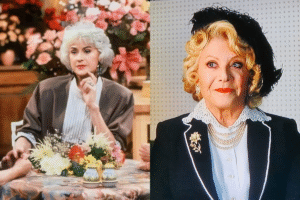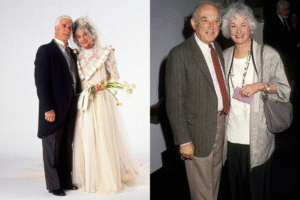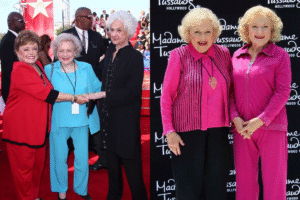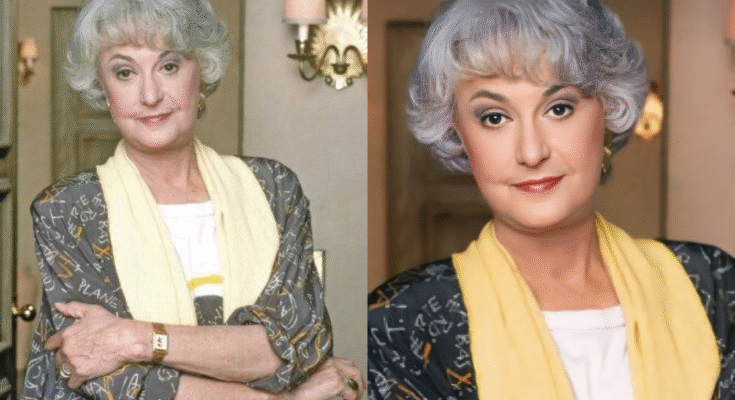Introduction: The Substitute Teacher Who Captured America’s Heart
Dorothy Zbornak stands as one of television’s most beloved characters, a testament to the power of intelligent writing and brilliant performance. Portrayed by the incomparable Bea Arthur in NBC’s groundbreaking sitcom “The Golden Girls” (1985-1992), Dorothy represented something revolutionary for 1980s television: a divorced woman in her 60s who was sharp, independent, and unapologetically herself. Her character broke stereotypes about aging, femininity, and what it meant to be a leading lady on primetime television.
In an era when television often relegated older women to background roles as sweet grandmothers or comic relief, Dorothy Zbornak emerged as a fully realized character with depth, vulnerability, and a razor-sharp wit that could cut through any pretense. She was neither a caricature nor a stereotype, but a complex woman navigating life’s challenges with intelligence, humor, and occasional exasperation.
Early Life and Background
Brooklyn Beginnings
Dorothy Petrillo was born in Brooklyn, New York, in the 1930s to Sicilian immigrants Sophia and Salvadore Petrillo. Growing up in a working-class Italian-American household during the Great Depression shaped much of Dorothy’s worldview and character. The eldest child in the family, Dorothy learned early the value of education and hard work, traits that would define her throughout her life.
Her childhood in Brooklyn was marked by the typical struggles of immigrant families trying to establish themselves in America. Sophia often recounted stories of their poverty, though these tales were sometimes embellished for dramatic effect. Despite financial hardships, the Petrillo household was rich in love, tradition, and the kind of sharp-tongued humor that would become Dorothy’s trademark.
Education: A Path to Independence
Dorothy’s intelligence was evident from an early age. She excelled in school, finding in education both an escape from her circumstances and a path to a better future. Her love of learning wasn’t just academic; it represented freedom, possibility, and self-determination. This passion for education would later define her career as a substitute teacher, where she could pass on her love of learning to new generations.
Her academic achievements were particularly notable given the era’s limited expectations for women’s education. Dorothy pursued her studies with determination, earning her degree despite societal pressures to focus solely on marriage and family. This educational foundation gave her the confidence and intellectual tools she would need to navigate life’s challenges.
The Fateful Marriage to Stan Zbornak
Dorothy’s life took a dramatic turn when, at age 17, she became pregnant after a romantic encounter with Stanley “Stan” Zbornak. In 1950s America, there was only one socially acceptable option: marriage. This hasty union would shape the next 38 years of Dorothy’s life and become one of her defining experiences.
Stan Zbornak was a novelty salesman with grand dreams but little follow-through. Their marriage was marked by his chronic infidelity, failed business ventures, and inability to mature into a responsible partner. Despite these challenges, Dorothy remained in the marriage for nearly four decades, partly out of duty, partly for their children, and partly because divorce carried significant stigma in her generation.
Family Dynamics and Relationships
Children: Michael and Kate
Dorothy and Stan had two children: Michael and Kate. As a mother, Dorothy was loving but practical, encouraging her children’s education while preparing them for life’s realities. Her relationship with her children reflected her own values: the importance of independence, education, and maintaining one’s dignity even in difficult circumstances.
Michael, her son, inherited his mother’s intelligence but struggled to find his path in life. His various career changes and personal challenges were a source of both pride and concern for Dorothy. Kate, her daughter, was more settled but geographically distant, living in New York while maintaining a close emotional bond with her mother.
The experience of raising children while managing a difficult marriage and maintaining a career showcased Dorothy’s remarkable strength. She juggled multiple responsibilities with grace, even when Stan’s unreliability meant she often functioned as a single parent.
The Complicated Relationship with Stan
Stan Zbornak remained a significant figure in Dorothy’s life even after their divorce. His sudden departure for a younger woman after 38 years of marriage was both devastating and liberating for Dorothy. The divorce forced her to rebuild her life at an age when many people are settling into retirement, but it also freed her from a relationship that had long ceased to nurture her.
Throughout the series, Stan’s recurring appearances served as both comic relief and poignant reminders of Dorothy’s past. Their interactions revealed the complex emotions that remain after a long marriage ends: anger, disappointment, lingering affection, and the peculiar intimacy that comes from sharing decades of life together. Dorothy’s ability to maintain boundaries with Stan while occasionally showing compassion demonstrated her emotional maturity and growth.
Sophia: The Mother-Daughter Dynamic
Perhaps no relationship was more central to Dorothy’s character than her connection with her mother, Sophia. Their relationship inverted traditional parent-child dynamics, with Dorothy often serving as the responsible adult to Sophia’s impulsive elder. This role reversal created both comedy and touching moments throughout the series.
Sophia’s stroke, which damaged the part of her brain controlling her speech filter, meant Dorothy often had to manage her mother’s unfiltered comments and spontaneous schemes. Yet beneath the exasperation was deep love and mutual respect. Sophia’s stories of Sicily, her old-world wisdom, and her fierce protection of her daughter revealed the strong foundation of their bond.
Their relationship also highlighted generational differences in approaching life’s challenges. Where Sophia relied on intuition and traditional wisdom, Dorothy favored logic and modern solutions. These contrasts created friction but also complementary strengths that enriched both characters.
Life at 6151 Richmond Street
The Miami Chapter
After her divorce, Dorothy made the bold decision to relocate to Miami, Florida, where she moved in with her mother at Shady Pines retirement home. When Shady Pines burned down (an event Sophia never let anyone forget), they needed new accommodations. This led them to answer an advertisement for roommates placed by Blanche Devereaux, marking the beginning of a new chapter in Dorothy’s life.
The house at 6151 Richmond Street became more than just a residence; it was a sanctuary where Dorothy could rebuild her identity outside the shadow of her failed marriage. The Miami setting, with its vibrant culture and relaxed atmosphere, provided a stark contrast to her Brooklyn roots and allowed Dorothy to explore new aspects of her personality.
The Roommate Dynamic
Living with Blanche Devereaux and Rose Nylund created a unique household dynamic that challenged and enriched Dorothy’s life. These women, so different in personality and background, became her chosen family, offering support, friendship, and endless opportunities for both frustration and laughter.

With Blanche, Dorothy found both a foil and a friend. Blanche’s overt sexuality and Southern belle persona clashed with Dorothy’s more reserved Northeast sensibilities, yet they developed a deep respect for each other. Dorothy often served as Blanche’s reality check, while Blanche encouraged Dorothy to embrace her own sexuality and desirability.
Rose presented a different dynamic. Her innocent worldview and endless stories from St. Olaf, Minnesota, tested Dorothy’s patience, yet Rose’s genuine kindness and optimism provided balance to Dorothy’s sometimes cynical outlook. Their friendship demonstrated that intellectual differences need not prevent deep emotional connections.
Career and Professional Life
The Substitute Teacher
Dorothy’s career as a substitute teacher was more than just a job; it was a vocation that reflected her deepest values. Education had been her path to independence, and she devoted herself to providing that same opportunity to others. As a substitute, she faced unique challenges: establishing authority quickly, adapting to different schools and curricula, and managing students who often saw substitutes as easy targets for misbehavior.
Her teaching style combined high standards with genuine care for her students’ success. Dorothy refused to lower her expectations, believing that doing so would be a disservice to her students. This approach wasn’t always popular, but it earned respect from students who recognized her genuine investment in their education.
The financial instability of substitute teaching added stress to Dorothy’s life, particularly as she navigated post-divorce financial independence. Yet she persisted in her chosen profession, finding meaning and purpose in the classroom even when the monetary rewards were minimal.
Other Professional Ventures
Throughout the series, Dorothy explored various professional opportunities beyond teaching. These ventures revealed her adaptability and willingness to challenge herself even in her later years. Whether working at a museum, tutoring privately, or considering other career changes, Dorothy demonstrated that reinvention is possible at any age.
Her brief stint as a writer showcased another facet of her intelligence and creativity. Dorothy’s attempt to write her own life story revealed both her literary ambitions and her struggle to see her own life as worthy of documentation, a common challenge for women whose contributions often go unrecognized.
Personal Characteristics and Personality
Intelligence and Wit
Dorothy’s intelligence was perhaps her most defining characteristic. She possessed not just book learning but emotional intelligence, cultural awareness, and the ability to see through pretense. Her wit was legendary, delivered with perfect timing and Bea Arthur’s distinctive deadpan style. These verbal zingers weren’t just funny; they revealed Dorothy’s acute observations about human nature and social dynamics.
Her humor often served as a defense mechanism, a way to maintain dignity in undignified situations. Whether dealing with Stan’s latest scheme, Rose’s naïveté, or Blanche’s romantic dramas, Dorothy’s sarcastic commentary provided both entertainment and insight.
Vulnerabilities and Insecurities
Despite her strong exterior, Dorothy harbored deep insecurities, particularly about her attractiveness and desirability. Years of Stan’s infidelity had damaged her self-esteem, and she often compared herself unfavorably to more conventionally feminine women like Blanche. These insecurities made her romantic victories all the more meaningful and her eventual happiness with Lucas Hollingsworth particularly satisfying.
Dorothy also struggled with anger and bitterness about her life’s disappointments. Her divorce, financial struggles, and the feeling that life had passed her by sometimes manifested as harsh judgment of others or self-pity. Yet she consistently worked to overcome these negative emotions, showing remarkable resilience and growth.
Fashion and Physical Presence
Dorothy’s fashion sense became iconic in its own right. Her preference for loose-fitting, flowing garments in bold patterns reflected both the 1980s aesthetic and her own comfort with her tall, imposing frame. Unlike Blanche’s overtly sexy wardrobe or Rose’s prairie-inspired outfits, Dorothy’s clothing choices prioritized comfort and dignity over conventional attractiveness.
Bea Arthur’s commanding physical presence brought Dorothy to life in ways that transcended the written word. At 5’9″, Arthur towered over her co-stars, and she used her height to great effect, whether intimidating adversaries or providing physical comedy. Dorothy’s body language, from her withering looks to her exasperated gestures, became as memorable as her dialogue.
Romantic Relationships
The Search for Love
Following her divorce, Dorothy’s journey to find romantic love again became a recurring theme throughout the series. Her dating experiences ranged from humorous disasters to genuine connections, each revealing different aspects of her character. These storylines challenged ageist assumptions about romance and sexuality, showing that the desire for love and companionship doesn’t diminish with age.
Dorothy’s romantic pursuits were often complicated by her high standards and fear of vulnerability. After decades with Stan, she was simultaneously desperate for genuine connection and terrified of being hurt again. This tension created both comedy and pathos, making her romantic storylines some of the series’ most compelling.
Notable Relationships
Several relationships stood out in Dorothy’s romantic journey. Her relationship with Elliott Clayton, despite his revealed bigamy, showed her capacity for passion and her unwillingness to compromise her principles. Her brief engagement to lawyer Ken demonstrated her desire for stability but also her recognition that stability without passion wasn’t enough.
The relationship with Sonny Bono’s character, Jake, revealed Dorothy’s ability to look beyond surface differences to find genuine connection. Each relationship taught her something about herself and what she truly wanted from a partner.
Lucas Hollingsworth: The Happy Ending
Dorothy’s relationship with Lucas Hollingsworth, played by Leslie Nielsen, represented the culmination of her romantic journey. Lucas was everything Stan wasn’t: reliable, cultured, genuinely interested in Dorothy’s intelligence, and capable of seeing her as desirable. Their courtship was mature and respectful, based on mutual interests and genuine compatibility.
Their wedding in the series finale provided Dorothy with the happy ending that had eluded her for so long. Yet it was a bittersweet victory, requiring her to leave the Miami family she had built. This departure underscored a crucial theme: that growth sometimes requires difficult choices and that new beginnings often mean endings as well.
Friendships and Social Life

The Core Friendship Group
The friendship between Dorothy, Blanche, Rose, and Sophia represented something revolutionary on television: older women whose lives centered on their friendships rather than their families. These relationships were complex, involving conflict, competition, support, and unconditional love. Dorothy often served as the group’s voice of reason, though she wasn’t above participating in their schemes and adventures.
The kitchen table conversations, where the women shared cheesecake and life’s problems, became iconic television moments. Dorothy’s contributions to these discussions combined practical advice, emotional support, and sharp observations about human nature. She could be both the comforting friend and the one who delivered hard truths when necessary.
Social Activities and Interests
Dorothy’s intellectual pursuits extended beyond her professional life. She was an avid reader, theater enthusiast, and enjoyed cultural activities that her roommates sometimes found pretentious. Her attempts to elevate her friends’ cultural awareness, while often met with resistance, showed her desire to share the things she loved.
Her involvement in various social causes and community activities revealed her sense of civic duty and desire to contribute to society. Whether participating in charity events, political campaigns, or community theater, Dorothy remained engaged with the world around her, refusing to retreat into isolation despite life’s disappointments.
Health Challenges and Aging
Chronic Fatigue Syndrome
One of the series’ most groundbreaking storylines involved Dorothy’s struggle with Chronic Fatigue Syndrome (CFS). At a time when this condition was poorly understood and often dismissed as psychological, the show depicted Dorothy’s frustration with doctors who refused to take her symptoms seriously. Her eventual diagnosis and validation provided representation for countless viewers experiencing similar medical gaslighting.
This storyline showcased Dorothy at her most vulnerable and determined. Her fight for proper medical care, her anger at being dismissed, and her relief at finally being believed resonated with audiences and helped raise awareness about CFS and the broader issue of women’s health concerns being minimized by medical professionals.
Aging and Body Image
Dorothy’s relationship with her aging body was complex and honest. She struggled with society’s invisibility of older women while maintaining dignity and self-respect. Her journey toward self-acceptance, while never complete, provided a realistic portrayal of aging in a youth-obsessed culture.
The show didn’t shy away from discussing menopause, changing sexuality, and the physical challenges of aging. Dorothy’s frank discussions about these topics helped normalize conversations that were often considered taboo on primetime television.
Cultural Impact and Legacy
Representation Matters
Dorothy Zbornak’s significance extends far beyond entertainment. She represented a demographic typically ignored by mainstream media: divorced older women rebuilding their lives. Her character challenged stereotypes about aging, showing that life after 60 could involve romance, career changes, new friendships, and personal growth.
For many viewers, particularly women who had experienced similar life challenges, Dorothy provided both representation and inspiration. Her struggles with divorce, single parenthood, career challenges, and aging resonated with audiences who rarely saw their experiences reflected on screen.
Influence on Television
Dorothy’s character influenced how older women were portrayed on television. Her complexity, intelligence, and full emotional life paved the way for more nuanced representations of aging characters. Shows that followed “The Golden Girls” often drew inspiration from its model of older women as fully realized characters rather than stereotypes.
The success of Dorothy and her roommates proved that audiences were hungry for diverse stories that went beyond traditional family sitcoms. This opened doors for more experimental and inclusive programming that centered on previously marginalized perspectives.
Feminist Icon
Dorothy became an unexpected feminist icon, embodying independence, intelligence, and self-determination. Her refusal to be diminished by age, divorce, or societal expectations resonated with feminist audiences who saw in her a model of resistance against patriarchal norms.
Her feminism wasn’t explicit or political but lived through her daily choices: pursuing education, maintaining financial independence, refusing to settle for less than she deserved in relationships, and supporting other women even when they frustrated her. This everyday feminism made her accessible to audiences who might have been alienated by more overtly political characters.
Memorable Episodes and Storylines
“Dorothy’s New Friend”
This episode explored Dorothy’s intellectual loneliness and her joy at finding a friend who shared her cultural interests. When this friend rejected the other girls as not sophisticated enough, Dorothy had to choose between intellectual stimulation and loyalty to her chosen family. Her choice reinforced the series’ message about the value of genuine friendship over superficial compatibility.
“The Way We Was”
Through flashbacks, this episode revealed the early days of Dorothy and Stan’s relationship, providing context for Dorothy’s bitterness and disappointment. Seeing young Dorothy’s hopes and dreams made her present-day cynicism both more understandable and more poignant.
“Sick and Tired” (Parts 1 & 2)
The Chronic Fatigue Syndrome storyline represented the series at its most serious and socially conscious. Dorothy’s struggle for diagnosis and respect highlighted issues in the medical system that remain relevant today. Her confrontation with the dismissive doctor who finally had to acknowledge her condition provided a cathartic moment for viewers who had experienced similar medical gaslighting.
“Mother’s Day”

Dorothy’s complicated relationship with motherhood was explored when she considered what kind of mother she had been. Her fears that she had repeated her mother’s mistakes with her own children revealed her vulnerability and desire to have done better, universal concerns for parents.
“Dorothy’s Prized Pupil”
When Dorothy tutored a promising student who was an undocumented immigrant, the episode tackled immigration issues with sensitivity and nuance. Dorothy’s advocacy for her student showed her principles in action and her willingness to fight for what she believed was right.
The Departure: Starting a New Chapter
The Decision to Leave
Dorothy’s decision to marry Lucas and move to Atlanta represented enormous growth. After years of prioritizing others’ needs, she chose her own happiness. This decision wasn’t made lightly; leaving her mother and best friends was painful, but it showed Dorothy’s recognition that she deserved a full life beyond caregiving and compromise.
The two-part finale, “One Flew Out of the Cuckoo’s Nest” and “The Way We Was,” provided closure while acknowledging the bittersweetness of change. Dorothy’s goodbye to each roommate revealed the depth of these relationships and the difficulty of leaving even when moving toward something positive.
Impact on the Remaining Characters
Dorothy’s departure fundamentally changed the dynamic of the remaining characters. Her absence was felt not just emotionally but practically; she had been the group’s anchor, the voice of reason, and often the problem-solver. The short-lived sequel series “The Golden Palace” struggled partly because Dorothy’s presence was so integral to the original show’s chemistry.
Guest Appearances and Continued Presence
Even after leaving the main series, Dorothy returned for guest appearances in “The Golden Palace,” showing that while she had moved on, the bonds with her chosen family remained strong. These appearances provided fans with closure and reinforced that growth doesn’t mean abandoning important relationships.
Bea Arthur: The Woman Behind Dorothy
Casting Perfection
The role of Dorothy Zbornak seemed written for Bea Arthur, though she was actually the last of the four leads to be cast. Her distinctive voice, impeccable timing, and ability to deliver both comedy and drama made her irreplaceable in the role. Arthur brought gravitas to what could have been a one-dimensional character, finding layers of complexity in Dorothy’s personality.
Arthur’s own personality influenced Dorothy’s character development. Her real-life intelligence, activism, and no-nonsense attitude informed Dorothy’s portrayal. The writers often tailored scripts to Arthur’s strengths, creating a synergy between actor and character rarely seen on television.
Performance Style
Bea Arthur’s performance style was unique in sitcom history. She rejected the typical sitcom mugging and over-the-top reactions, instead opting for a more naturalistic approach that grounded the show’s sometimes absurd situations. Her ability to deliver a withering look was legendary, conveying more with a glance than most actors could with a monologue.
Her chemistry with the other cast members, particularly Estelle Getty as Sophia, created magic on screen. The mother-daughter dynamic between Dorothy and Sophia was enhanced by Arthur and Getty’s real-life friendship and mutual respect.
Beyond Dorothy
While Dorothy Zbornak became Bea Arthur’s most famous role, it built on a distinguished career that included Broadway success and her groundbreaking role as Maude Findlay. Arthur’s portrayal of strong, independent women throughout her career helped change perceptions about women’s roles in entertainment and society.
Arthur’s activism and philanthropy, particularly her support for LGBTQ+ rights and animal welfare, reflected values that aligned with Dorothy’s principles. This authenticity contributed to the character’s believability and impact.
Themes and Social Commentary
Aging in America
Through Dorothy’s experiences, “The Golden Girls” addressed the marginalization of older adults in American society. Dorothy’s struggles with employment discrimination, medical dismissal, and social invisibility highlighted real issues facing aging Americans. Yet the show also celebrated the possibilities of later life, showing that growth, romance, and adventure don’t have an expiration date.
Divorce and Starting Over
Dorothy’s post-divorce journey provided representation for the growing number of divorced older women in the 1980s. Her financial struggles, dating challenges, and identity reconstruction resonated with viewers experiencing similar transitions. The show treated divorce not as failure but as an opportunity for rebirth, a radical message for its time.
Female Friendship
The centrality of female friendship in Dorothy’s life challenged the notion that women’s primary relationships must be romantic or familial. Her friendships with Blanche and Rose showed that chosen family could be as meaningful as biological family, and that women’s friendships deserved to be the center of narrative attention.
Education and Intellectualism
Dorothy’s commitment to education and intellectual pursuits challenged anti-intellectual trends in American culture. She refused to apologize for her intelligence or cultural interests, modeling the importance of lifelong learning and critical thinking.
Family Dynamics

The complex relationship between Dorothy and Sophia explored changing dynamics as parents age and children become caregivers. Their role reversal, while played for comedy, addressed serious issues about aging parents, family responsibility, and maintaining dignity while needing care.
Dorothy’s Humor: A Closer Look
The Art of the Comeback
Dorothy’s quick wit and sharp tongue produced some of television’s most memorable comebacks. Her ability to deflate pomposity, call out hypocrisy, and deliver the perfect retort made her the queen of the verbal takedown. These moments weren’t just funny; they showed Dorothy using humor as power, turning her intelligence into a weapon against those who would diminish her.
Self-Deprecating Humor
While Dorothy could be cutting toward others, she also possessed the ability to laugh at herself. Her self-deprecating humor about her appearance, romantic failures, and life disappointments showed emotional intelligence and prevented her from becoming merely bitter or mean-spirited.
Physical Comedy
Despite her dignified bearing, Dorothy wasn’t above physical comedy. Bea Arthur’s willingness to be silly, whether in costume for one of Rose’s schemes or reacting to one of life’s absurdities, added dimension to the character. These moments of physical comedy humanized Dorothy and showed that dignity didn’t require constant seriousness.
Relationships with Men
Father Issues
Dorothy’s relationship with her largely absent father influenced her relationships with men throughout her life. His early death and limited presence during her childhood created a template for accepting less than she deserved from male partners. Understanding this pattern was part of Dorothy’s growth journey.
Professional Relationships
Dorothy’s interactions with male colleagues and authority figures revealed the sexism she faced as an educated woman of her generation. Her struggles to be taken seriously professionally, particularly in medical and academic settings, reflected broader societal issues about women’s credibility and authority.
Platonic Friendships
While less common, Dorothy’s platonic friendships with men showed her ability to connect beyond romance. These relationships, whether with colleagues or neighbors, demonstrated that she valued intellectual and emotional connection regardless of gender.
Dorothy’s Evolution Throughout the Series
Season 1-3: Finding Her Footing
In the early seasons, Dorothy was still raw from her divorce, angry and uncertain about her future. Her bitterness was more pronounced, her insecurities more visible. These seasons established her character’s core traits while showing her beginning to build a new life.
Season 4-5: Growing Confidence
The middle seasons showed Dorothy gaining confidence in her new life. She became more comfortable with dating, more assertive in her career, and more secure in her friendships. Her humor became less defensive and more playful as she settled into her new identity.
Season 6-7: Full Bloom
The final seasons presented Dorothy at her most self-actualized. While still maintaining her core personality, she showed greater emotional openness, willingness to take risks, and ability to embrace joy. Her relationship with Lucas represented the culmination of this growth, showing a Dorothy ready for healthy love.
Impact on Popular Culture
Quotable Moments
Dorothy’s lines became part of the cultural lexicon. Phrases like “Picture it,” (though more associated with Sophia, Dorothy’s reactions made them memorable), and her various withering responses entered everyday conversation. Her verbal style influenced how people, particularly women, thought about using wit as empowerment.
Memes and Modern Relevance
In the digital age, Dorothy’s expressions and quotes found new life as memes and GIFs. Her eye rolls, exasperated looks, and cutting remarks proved perfectly suited for online communication, introducing her to new generations who discovered the show through streaming services.
Drag Culture and LGBTQ+ Icon Status
Dorothy, like all the Golden Girls, became an icon in drag culture and the LGBTQ+ community. Her combination of strength, vulnerability, wit, and glamour (in her own unique way) resonated with communities that understood outsider status and the power of chosen family.
The Golden Girls’ Ensemble Dynamic
Dorothy as the Straight Woman

In comedy terms, Dorothy often served as the “straight woman” to her roommates’ more eccentric personalities. Her reactions to Rose’s stories, Blanche’s escapades, and Sophia’s schemes provided much of the show’s humor. Yet she was far more than just a reactive character; her own neuroses and adventures drove many storylines.
Leadership and Mediation
Within the household, Dorothy often assumed a leadership role during crises. Her logical thinking and problem-solving abilities made her the natural person to turn to when things went wrong. Yet the show was careful to show that each woman had her own strengths, and Dorothy learned from her roommates as much as she taught them.
Emotional Center
Despite her sometimes harsh exterior, Dorothy served as the emotional center of many episodes. Her vulnerabilities and struggles often drove the show’s more serious moments, providing balance to the comedy and giving the show its heart.
Fashion Evolution and Style Analysis
The Signature Look
Dorothy’s fashion choices became as iconic as her personality. Her preference for loose, flowing garments in bold prints and solid colors created a distinctive silhouette that was both comfortable and commanding. This style choice reflected both 1980s fashion trends and Dorothy’s personal comfort with her body.
Symbolic Styling
The contrast between Dorothy’s conservative, covered-up style and Blanche’s more revealing wardrobe represented their different approaches to femininity and sexuality. Dorothy’s clothes suggested a woman who wanted to be taken seriously for her mind rather than her body, though later seasons showed her experimenting with more form-fitting and feminine styles as she became more confident.
Special Occasion Wear
When Dorothy dressed up for special occasions, the transformation was always significant. These moments showed that beneath her everyday practical style was a woman who could embrace glamour when she chose to. Her wedding dress in the series finale represented the ultimate transformation: traditional, elegant, and radiantly happy.
Teaching Philosophy and Educational Impact
Progressive Education
Despite her traditional appearance, Dorothy’s teaching philosophy was surprisingly progressive. She believed in challenging students rather than coddling them, maintaining high standards while providing support. Her approach to education emphasized critical thinking over rote memorization, understanding over compliance.
Representation of Teachers
Dorothy provided rare positive representation of teachers on television. While often shown as frustrated with the education system, she never lost faith in education’s transformative power. Her portrayal honored the teaching profession and highlighted both its challenges and rewards.
Lifelong Learning
Dorothy embodied the principle of lifelong learning. Her curiosity about the world, willingness to admit when she was wrong, and openness to new experiences (even when skeptical) modeled intellectual humility and growth. She showed that education wasn’t just about formal schooling but about remaining open to life’s lessons.
Health and Wellness Journey
Mental Health
While not explicitly discussed in modern terms, Dorothy clearly dealt with depression and anxiety throughout the series. Her journey toward better mental health, though not labeled as such, provided representation for viewers struggling with similar issues. Her use of humor as a coping mechanism, while not always healthy, was realistically portrayed.
Physical Health Advocacy
Dorothy’s fight for proper medical care during her Chronic Fatigue Syndrome storyline made her an inadvertent health advocate. Her insistence on being heard and refusal to accept dismissive treatment resonated with many viewers who had similar experiences with the medical system.
Self-Care Evolution
Throughout the series, Dorothy learned the importance of self-care, though the term wasn’t used. Her growing ability to prioritize her own needs, set boundaries, and seek joy showed a woman learning that self-sacrifice wasn’t always virtuous.
Conclusion: Dorothy’s Enduring Legacy
Dorothy Zbornak remains one of television’s most complex and beloved characters nearly four decades after her debut. She represented a revolution in how older women were portrayed on screen: fully human, sexually active, intellectually vibrant, and capable of growth and change at any age.
Her impact extends beyond entertainment. Dorothy provided representation for divorced women rebuilding their lives, teachers fighting for respect, daughters caring for aging parents, and anyone who felt invisible or dismissed by society. She showed that wit could be weapon and shield, that vulnerability didn’t negate strength, and that it’s never too late for a second act in life.
The character’s enduring popularity speaks to the universality of her struggles and triumphs. Dorothy’s journey from bitter divorcée to fulfilled newlywed wasn’t just about finding romantic love; it was about self-discovery, friendship, and learning to believe in one’s own worth. Her sharp tongue and soft heart created a character who was both aspirational and relatable, someone viewers could admire while recognizing their own flaws and strengths in her story.
In an era of peak television with countless channels and streaming options, Dorothy Zbornak still stands out as a singular creation. She proved that audiences were hungry for stories about women whose lives didn’t end at 40, whose experiences mattered regardless of their age or marital status, and whose friendships were as important as any romantic relationship.
As we continue to grapple with issues of aging, healthcare, divorce, and women’s autonomy, Dorothy’s story remains relevant. Her struggles with medical gaslighting, employment discrimination, and social invisibility continue to resonate. Her victories in friendship, love, and self-acceptance continue to inspire.
Dorothy Zbornak was more than just a character; she was a mirror held up to society, reflecting both its failures and its possibilities. Through her, millions of viewers saw themselves represented, validated, and celebrated. Her legacy lives on not just in reruns and streaming services, but in the countless lives she touched and the doors she opened for more diverse, complex representations of women on screen.
The substitute teacher from Brooklyn who rebuilt her life in Miami taught us all valuable lessons: that intelligence is attractive at any age, that friendship can sustain us through life’s challenges, that it’s never too late to start over, and that everyone deserves a chance at happiness. Dorothy Zbornak may have left Miami for Atlanta in the series finale, but she never left our hearts or our cultural consciousness. Her influence continues to shape how we think about aging, friendship, and the endless possibilities of life’s second acts.
In a television landscape that often privileges youth and conventional beauty, Dorothy Zbornak stood tall—literally and figuratively—as a testament to the power of good writing, brilliant performance, and the revolutionary idea that older women’s stories matter. She remains, now and forever, picture-perfect proof that the best things in life, like the finest cheesecake, only get better with age.



